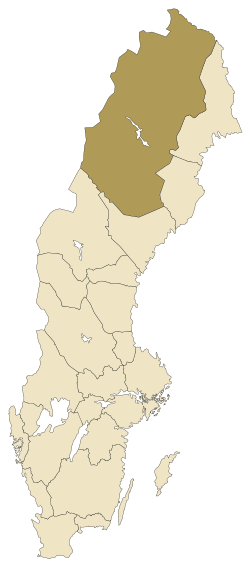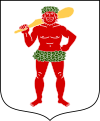Lapland (Sweden) facts for kids
Quick facts for kids
Lapland
|
||
|---|---|---|
|
||
 |
||
| Country | Sweden | |
| Land | Norrland | |
| Counties | Västerbotten County Norrbotten County Jämtland County |
|
| Area | ||
| • Total | 109,702 km2 (42,356 sq mi) | |
| Population
(2017)
|
||
| • Total | 91,333 | |
| • Density | 0.832555/km2 (2.156309/sq mi) | |
| Ethnicity | ||
| • Language | Swedish, Sami Meänkieli | |
| Culture | ||
| • Flower | Mountain avens | |
| • Animal | Arctic fox, Lynx, Reindeer | |
| • Bird | Bluethroat | |
| • Fish | Salvelinus | |
| Time zone | UTC+1 (CET) | |
| • Summer (DST) | UTC+2 (CEST) | |
Lapland, also called Lappland in Swedish, is a large area in northern Sweden. It is a historical province, which means it's a traditional region rather than a modern administrative one. Lapland shares borders with other Swedish provinces like Jämtland and Norrbotten. It also borders the countries of Norway and Finland. This amazing region makes up almost a quarter of Sweden's total land area.
Lapland used to be even bigger, stretching further east. But in 1809, a historical event changed its shape. The Russian Empire took over the eastern part of Sweden. This led to the creation of the Grand Duchy of Finland. This event divided Lapland into two parts: one in Sweden and one in Finland. Both parts still exist today. The Swedish part of Lapland is mostly found in the inland areas of Västerbotten County and Norrbotten County. Lapland has some of the coldest weather in Sweden. This is because it is far north and far from the sea.
Contents
Exploring Lapland's Past
The history of Lapland is closely linked to the history of Norrbotten County and Västerbotten County. This is because Lapland is a historic region within these counties.
Who Lived in Lapland Long Ago?
During the Middle Ages, people sometimes called Norrbotten and Lapland a "no man's land." However, this area was actually home to the Sami people. The Sami are nomadic people, meaning they traditionally moved from place to place. Over time, more settlers from Sweden, Finland, and Norway came to live in the region. They often settled along the coasts and big rivers.
How Did Lapland Change Over Time?
From the Middle Ages onwards, Swedish kings wanted to expand their kingdom and spread Christianity in the area. They encouraged settlers from what is now Finland and southern Sweden to move there. Today, many people in Lapland have adopted the main Swedish culture. However, Finnish and Sami people still work to keep their unique cultures and traditions alive.
What About Religion in Lapland?
In the 1600s and 1700s, the Sami people's original spiritual beliefs, called shamanism, changed. Most people in Lapland became Lutheran, which is a type of Christianity. Since the 1800s, a special kind of Lutheranism called Laestadianism has been very important in Lapland.
How Did Lapland Become Modern?
In the late 1800s, Sweden went through a big change called the industrialization of Sweden. During this time, Lapland's natural resources became very important. These resources included hydroelectricity (power from water), timber (wood from forests), and minerals. Even today, mining, forestry, and hydroelectric power are the main parts of Lapland's economy. These industries, along with local government services, provide many jobs.
Discovering Lapland's Natural Beauty
Lapland in Sweden is famous for its incredible natural places. It is home to the Vindelfjällen Nature Reserve, which is one of the largest nature reserves in Sweden.
What are Lapland's Special Natural Areas?
Some parts of Lapland are so special that they have been named a UNESCO World Heritage Site. This area is called the Laponian area. Lapland also has some of the oldest and most beautiful national parks in northern Europe. For example, Sarek National Park was created way back in 1909. Lapland is huge, covering about 109,702 square kilometers (about 42,300 square miles). This makes it larger than countries like Austria and almost as big as Portugal. It's even bigger than the Benelux countries (Belgium, Netherlands, Luxembourg) combined!
Lapland's Amazing National Parks
Lapland is home to several stunning national parks, perfect for exploring nature:
- Abisko
- Björnlandet
- Muddus
- Padjelanta
- Sarek
- Stora Sjöfallet
- Vadvetjåkka
How Lapland is Governed
The traditional provinces of Sweden like Lapland do not have administrative or political power today. They are mainly important for culture and history.
How are Decisions Made in Lapland?
Administratively, Lapland is part of two modern counties of Sweden. The northern part is in Norrbotten County, and the southern part is in Västerbotten County. Unlike many other parts of Sweden, people in these areas often feel more connected to their "counties" than to the "provinces." So, when they say 'Norrbotten' or 'Västerbotten,' they usually mean the whole county, including the parts that are in Lapland.
What About the Sami People's Rights?
People of Sami descent have the right to vote and run in elections for the Swedish Sami Parliament. This is true for Sami people all over Sweden. The Sami language is an official minority language in several municipalities within Lapland. These include Kiruna Municipality, Gällivare Municipality, Jokkmokk Municipality, and Arjeplog Municipality.
Which Towns are in Lapland?
The following municipalities (local government areas) have their main towns located in Lapland:
- Arjeplog
- Arvidsjaur
- Dorotea
- Gällivare
- Jokkmokk
- Kiruna
- Lycksele
- Malå
- Sorsele
- Storuman
- Vilhelmina
- Åsele
People and Cities in Lapland
As of December 31, 2017, about 91,333 people live in Swedish Lapland. If you include the Finnish part of historical Lapland, the total population is around 250,000 people.
What are Lapland's Biggest Cities?
The largest cities in Swedish Lapland are:
- Kiruna (also called Northern Sami: Giron or Finnish: Kiiruna) with 23,178 people.
- Gällivare with 18,123 people.
- Lycksele with 12,177 people.
Population by County
Here's how the population is spread out in the municipalities within Lapland:
- Kiruna (23,178)
- Gällivare (18,123)
- Jokkmokk (5,072)
- Arjeplog (2,887)
- Arvidsjaur (6,471)
- Lycksele (12,177)
- Vilhelmina (6,829)
- Storuman (5,943)
- Malå (3,109)
- Åsele (2,814)
- Dorotea (2,740)
- Sorsele (2,516)
Understanding Lapland's Climate
Lapland has a subarctic climate in its lower areas. This means it has long, cold winters and short, cool summers. In higher areas, like Tarfala research station, you can find a polar climate. Here, even the warmest month (July) has an average temperature below 10°C (50°F).
Why is Lapland's Weather So Different?
The southern parts of Lapland are much milder than the northern parts. This is due to the huge differences in geography. However, because Lapland is mostly inland, the sea doesn't have much effect on its weather. This leads to very harsh winters. Southern areas at lower elevations, like Lycksele, can have relatively warm summers.
What About the Midnight Sun?
Because the northern parts of Lapland are above the arctic circle, they experience the midnight sun. This means the sun stays visible for 24 hours a day during summer. In winter, they have a moderate polar night, where the sun doesn't rise for a period, but there is still some twilight.
Lapland's Unique Culture
The culture of Lapland is strongly influenced by several groups and movements. The Sami people are an important national minority group here. The Tornedalians are another distinct group. Also, the conservative Lutheran Laestadian movement plays a big role in the region's culture.
Images for kids
Error: no page names specified (help).
- Laponia (the province before 1809, including the present-day Finnish part)
- Lappmarken
- National parks in Lapland
- Finnish Lapland
- Sápmi (the larger traditional territory of the Sámi, often called "Lapland" or "Lappland" in English)
See also
 In Spanish: Laponia sueca para niños
In Spanish: Laponia sueca para niños






